THE ALTAR STONE
According to the codes
Shakespeare's final wishes are hidden here.
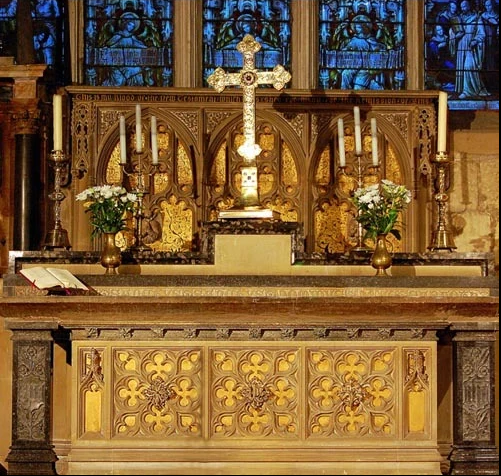
The altar at the church where Shakespeare is buried. Alan uncovered clues that something was hidden in the altar stone… and then obtained radar scan proof of it.
I had started my research in 2004 and by 2010 had made several trips to Stratford’s Holy Trinity Church, cultivating a relationship with the verger, the vicar, the congregant volunteers and eventually the bishop of the diocese.
During these extended visits I discovered an intricate system of codes hidden within the text of Shakespeare’s gravestone and monument suggesting he had hidden ‘something’ inside the church’s Holy of Holies altar stone just feet away from where he’s buried.
But how to prove such an outrageous hypothesis? I’m a jazz pianist, singer-songwriter, one-time recording artist for Arista Records and CBS… ex-musical director for a world-famous 60’s pop star. I clearly needed to get the opinion of a world-class cryptographer (if only to make sure I wasn’t going crazy).
I sent my findings to the legendary Whitfield Diffie, one of the pioneers of modern-day public-key cryptography. (In the late 70’s he paved the way for secure online commerce to eventually become possible).
He read my work, we met for dinner, and after showing him the codes that pointed to the altar stone he looked me straight in the eye and said, “If I were you… I’d radar scan that altar!” (Gulp.)
Easier said than done.
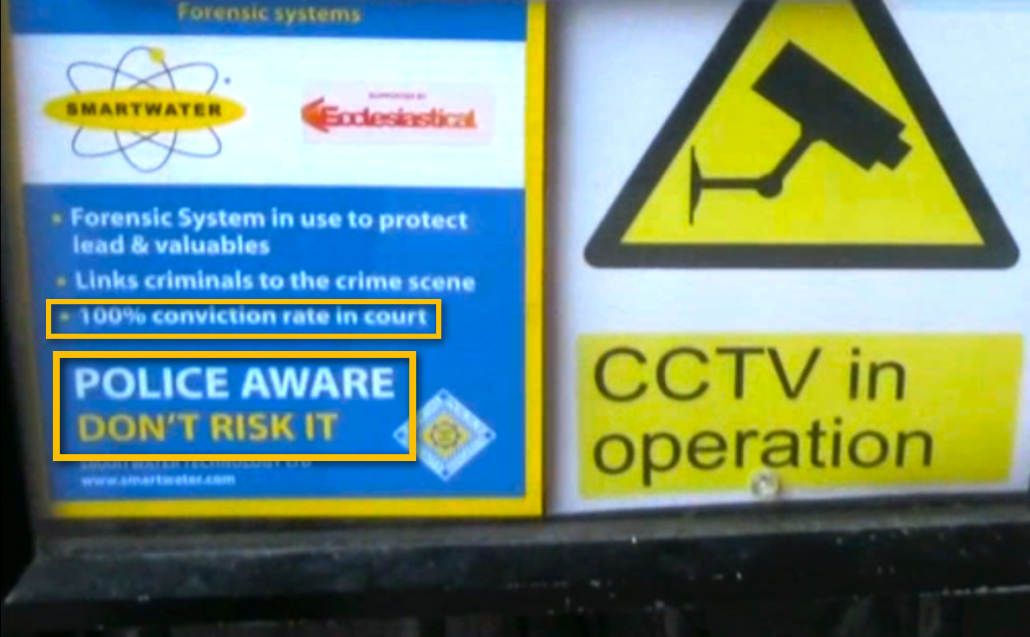
The entire church is monitored by 24-hour CCTV cameras and the altar and grave areas in particular are protected by a motion-detecting forensics system which sprays intruders with a chemical detectable on clothes or skin for up to a year! Signs at the church entrance declare: “DON’T RISK IT! 100% conviction rate in court.”
My dilemma was an excruciating mix of wild excitement balanced with extreme caution. I wanted to shout the news to the world but felt a heavy obligation to protect the discovery until its authenticity could be validated beyond doubt. But I realized Diffie was right; the only way to prove my hypothesis would be to radar scan the altar stone. And the chance of finding something that contradicted the official story meant there was no way the church would allow me to do that, at least not before they could investigate it themselves, in secret. And then what? If they found such evidence would we ever see it? Six years’ work (and a historic opportunity to show the world the only physical evidence left by Shakespeare himself) would all be gone. I couldn’t risk that.
Over time I had made myself useful to the church and been allowed special access not normally granted to the public. But it would require a military-style operation and nerves of steel (risking arrest and imprisonment!) to create a major distraction and disable the security systems long enough to scan the altar undetected. I hand-built a life-sized replica of the altar on which to develop and practice a plan; I hired two film crews and a radar technician, all sworn to secrecy; and we flew to England to pull off the most audacious heist in literary history.
It was impossible, of course, so I offered to do a free concert of excerpts from my Shakespeare musical, BARD, and donated the royalties from the show’s main theme song to the church. We did our first test operation in November of 2011, in which we proved it was possible, in front of an audience of church elders and a few congregants, to get a successful scan without detection. The main event was to take place on the Bard’s birthday, April 23rd, 2012: a more thorough backup scan in front of a larger audience.
THE STRATFORD HEIST
(See the covert scanning of the altar stone and the lab results that prove the validity of the codes.)
The Heist
Even our main camera crew didn’t know what was going on behind the banner. They thought they were just filming me doing a show for the church. In actuality our second crew was secretly hacking a 17th century mystery with 21st century technology!
"No lights!... camera!... action!"
For the finale I asked the verger to turn off all the lights in the church while the staff and elders lit dozens of candles under Shakespeare’s monument, around his gravestone, and on the piano. I then performed Sonnet 18 by candlelight in homage to the great dramatist.
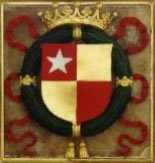
THE RESULTS
Radar scan proves the codes are authentic.
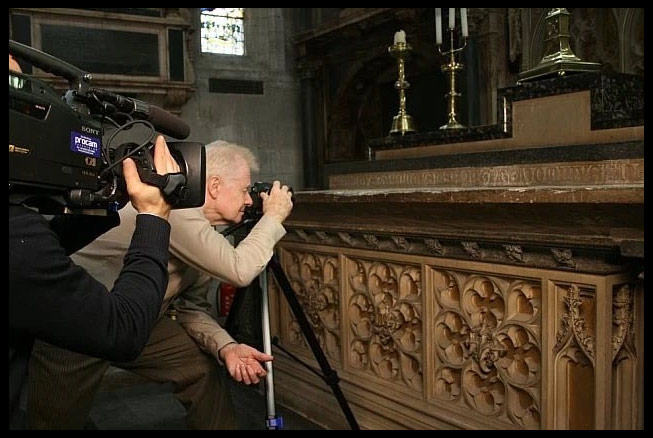
Alan photographing the extra stigmata cross on the side edge of the altar stone.

Close-up of the tell-tale five-pointed star – emblem of the De Vere family crest.
Above you see me taking extreme close-ups of the Holy of Holies altar stone while our cameraman films the discovery. The blown-up, high-resolution result (right) shows a five-pointed silver star within the right arm of the cross. (It’s barely visible to the naked eye but can be felt as a sharp pin-prick.) Inset is the De Vere heraldic crest which bears the same emblem. Incredibly, the star marks the precise spot where the codes predicted we would find the solution to the entire Shakespeare Mystery.
A couple of weeks later, safely back in Los Angeles (without having been arrested!) we finally heard back from the two US radar labs. Both had reached the same conclusion independently of one another. I now had slam-dunk proof of an enormous cavity. Below you see the radar results.
Even though the test scan at the first performance was done under rushed conditions the results were successful beyond our wildest imaginings! I now had the insurance I needed and flew back to Stratford to actually ask permission to scan. Bolstered by the results we’d already got with a scanner small enough to be hidden amongst our film gear, I had hopes of doing a second scan (permitted this time) with a larger system that would provide even greater detail.
Considering the church would have full rights to whatever might be found, the historical implications and potential windfall for them would frankly be incalculable! The closest comparison would be the recent discovery of a previously unknown da Vinci masterpiece but even that falls short because it was still just another da Vinci whereas this would be the only Shakespeare artifact in existence!
I offered to pay for the entire scanning operation so there’d be no financial risk to the church. My only condition was that it be done with media present to assure full transparency (so nothing could accidentally ‘disappear’ later?). Had they accepted my proposal I was prepared to reveal that I’d already done it and would’ve turned over the first radar results to them, then and there. The fact that the church refused speaks volumes. (And, of course, fully justified my having scanned first and asked later.)
THE "PRIESTLY BLESSING"
On April 22nd, 2012, I was invited to join the Bishop of Coventry, Christopher Cocksworth, and Rabbi Julia Neuberger, in offering the Birkat Kohanim blessing to the congregation as they left Holy Trinity Church after an inter-denominational service celebrating Shakespeare’s birthday. The ministers were utterly unaware that in choosing this ancient Hebrew blessing they were actually enacting the very 624 symbolism that is the central theme of the Shakespeare codes!
The following evening, on the poet’s ‘official’ birth date, we went ahead with our second filmed performance in the church chancel, just feet away from the altar stone overlooking Shakespeare’s grave and monument. Unfortunately, we were unable to pull off a second scan. Having turned down my request it was obvious the church elders were watching for any attempt to accomplish it.
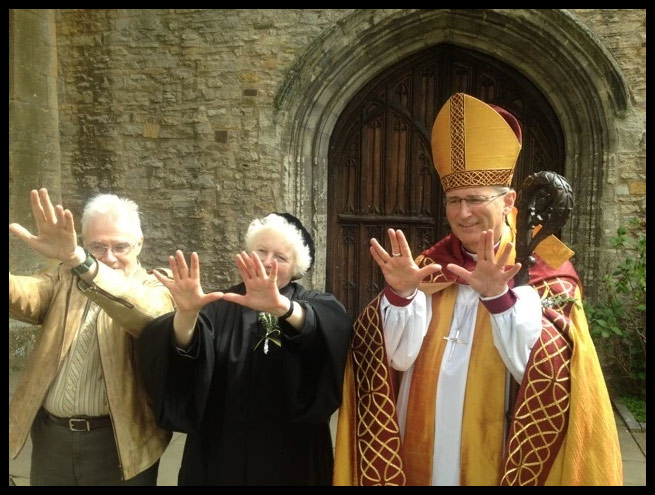

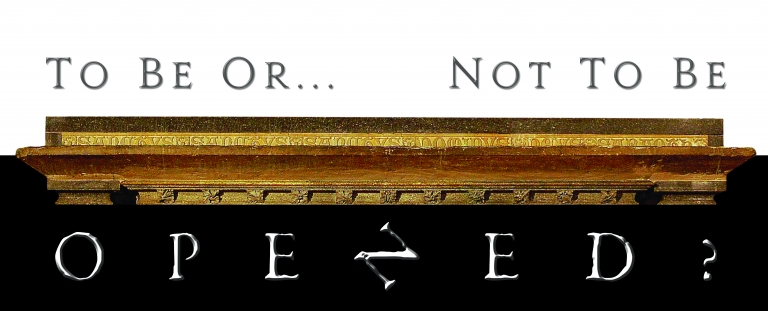
THE RESPONSE
Fear of the unknown.
After the performance I took questions from the congregation. The vicar, the reverend Martin Gorick, said it was “great fun” but I could sense he was under pressure to resist officially declaring he supported scanning the altar stone. (Of course he was unaware that I’d already done it.) The congregation was also not enthusiastic about rocking the boat. “If something is proven then that takes away the faith” said one concerned resident. I had no reason to doubt his sentiment was genuine. Nevertheless the majority of the townspeople’s livelihoods are dependent on the Stratford man remaining the Bard of Avon so their reticence to testing that theory is entirely understandable.
The Great Stratfordian Opportunity
Ever since the ‘authorship mystery’ was first raised a couple of centuries ago, the official Stratford position has consistently been that there is no mystery: the man from Stratford was Shakespeare. End of discussion. I understood their concerns over livelihoods being affected but I was actually there to offer an opportunity they probably had never considered. After all, up until now their habitual experience had been that anyone trying to ‘solve’ the mystery had started by attacking their town’s business enterprise – as though they personally were all in on some ‘scheme’ to defraud millions of tourists. I assured the congregation that, on the contrary, I was there to make them aware that Shakespeare himself had bestowed something on their town. A gift, hidden inside their very own altar stone, that could only bring them increased prosperity and standing in the world.
I explained they didn’t actually have to believe in the authenticity of the codes. Just the fact that there’s a possibility they’re genuine means the church has a spiritual obligation to investigate whether something is in there or not because if a Holy of Holies altar stone contains anything other than the original Saint’s relics it is, by definition, desecrated. (Granted Holy Trinity Church is no longer under Roman Catholic jurisdiction but it was, originally, and the altar stone is still, technically, a Roman Catholic relic.) The Reverend Gorick told me they consider themselves “Catholic Lite” so the church cannot in all conscience keep celebrating Mass at a desecrated altar; they would be constrained to empty it of any secular contents and re-consecrate the stone.
In fact they had nothing to lose and everything to gain because if the altar scan had shown there’s nothing there then my theory would be wrong and they’d be relieved of any doubt concerning the sacredness of their altar. Plus it would’ve cost them nothing because I had offered to pay for the scanning. If on the other hand the scan showed there was something there then it would automatically be considered desecrated and the church would have to remove any contents that didn’t belong and reconsecrate it. Since I had guaranteed to pay the costs of such an operation, again, they could not lose.
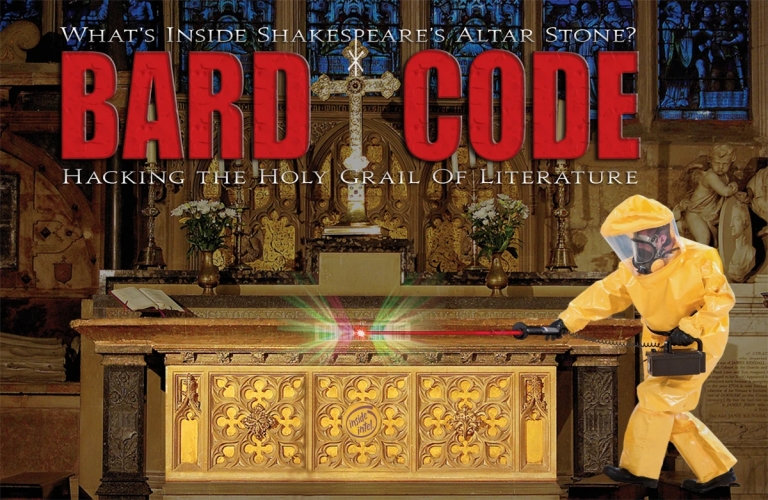
What's inside?
As I pointed out there were only three possible outcomes:
1)What’s in the stone proves the Stratford man was Shakespeare. Finally, after two centuries of awkward questions from the ‘anti-Stratfordian’ camps, it would be settled for good. The town could celebrate knowing their tourism and reputation was intact. Plus they would own priceless historical / literary relics the world would beat a path to see, bringing unprecedented prosperity to their town “to-morrow, and to-morrow, and to-morrow”.
2)What’s inside neither proves nor disproves the authorship, either way. But Stratford would still own the priceless relics and the story of their discovery would bring the same increases in tourism and good-will exposure to the town for having done the right thing.
3)What’s there proves someone else was actually the Bard. And although this would seem at first glance to be a disaster for their reputation and economy, in actuality nothing could be further from the truth. The world would still come in droves to see the priceless relics and Stratford would be hailed, worldwide, for having honored Shakespeare’s last wishes, as expressly stated in coded relics throughout their church.
Quite frankly at a time when scandals are undermining the public’s faith in organized religion more than at any time in history, it’s hard to imagine a greater opportunity for a church to stand out as an exemplar of spiritual principles of truth and ethical behavior. This really was (and could still be) their chance to renounce political motivation and embrace their core Christian values. Such an act would be celebrated around the world and couldn’t help but reinvigorate the faithful.
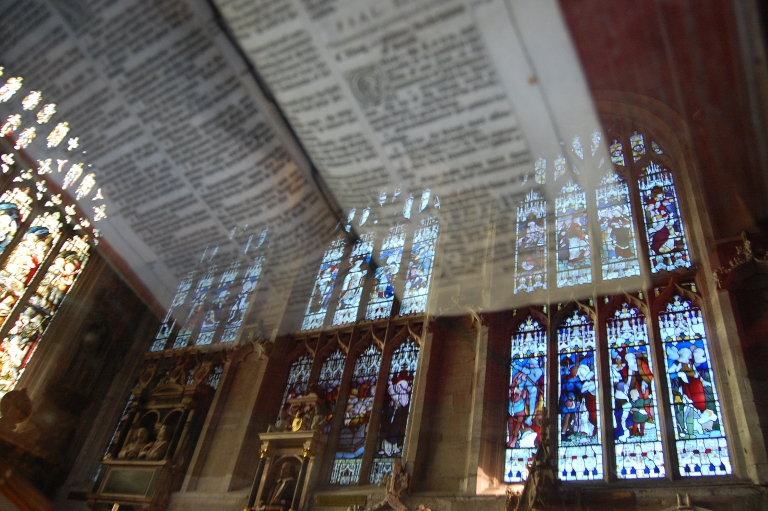
The Great Missed Opportunity
It made me truly sad to realize, at that moment, that I was right to have secured the scientific proof of the scan before asking permission, for I knew very well that Shakespeare had gone to enormous lengths to encode his secret and pass it along to the world. What could possibly have been so important to him that he would have risked his own safety to do it?
Regrettably I watched as fear and self preservation trumped ethics and spirituality. The town that owed its past, current and future prosperity almost entirely to the the greatest writer who ever lived, wasn’t interested in what he wanted. The phrases invented by their native son (if it was indeed he) had transformed the entire English language and literally fed them and their ancestors for generations… but the naked truth is his household words could not stir the milk of human kindness in them enough to honor his wishes. No, they would not do what his codes asked them to do… open the altar stone so he could be heard, at last.
Instead they circled the wagons. The bishop promised to get back to me after taking it to “a higher authority”. Given his own highly elevated position that could only mean the Queen or God and apparently they’ve both been busy because I’ve waited over eight years for the promised call back. In the meantime so much more material has surfaced that I’ve decided to finally go public because the truth of these discoveries will forever change our concept of this unparalleled genius. The codes say it’s what he wanted and frankly I’m more convinced than ever that without a public outcry his wishes will never be honored.
Someone back then carved a cavity approximately 250x the normal size of a saint’s reliquary into solid marble. You don’t do that unless you intend to put something of equivalent size into it. The space is large enough to hold not all but certainly some of the missing manuscripts of the most beloved plays in the world. Hamlet? Macbeth? A Midsummer Night’s Dream?… maybe even new, undiscovered masterpieces! Who knows? Who’d like to know?
If, on the news tonight, you learned that a wall in Leonardo da Vinci’s last home had been radar scanned and seems to indicate there might be a painting behind it, would you expect the authorities to say, “Ahh, let’s not bother. It’s awfully moldy back there.” How about if someone discovered a locked trunk under a trap door in Beethoven’s last apartment? Would you expect the landlord to shrug, “Meh. Beethoven’s Tenth? Who cares?”
Unfortunately that is exactly what Shakespeare’s church is saying by refusing the simple act of taking a look.

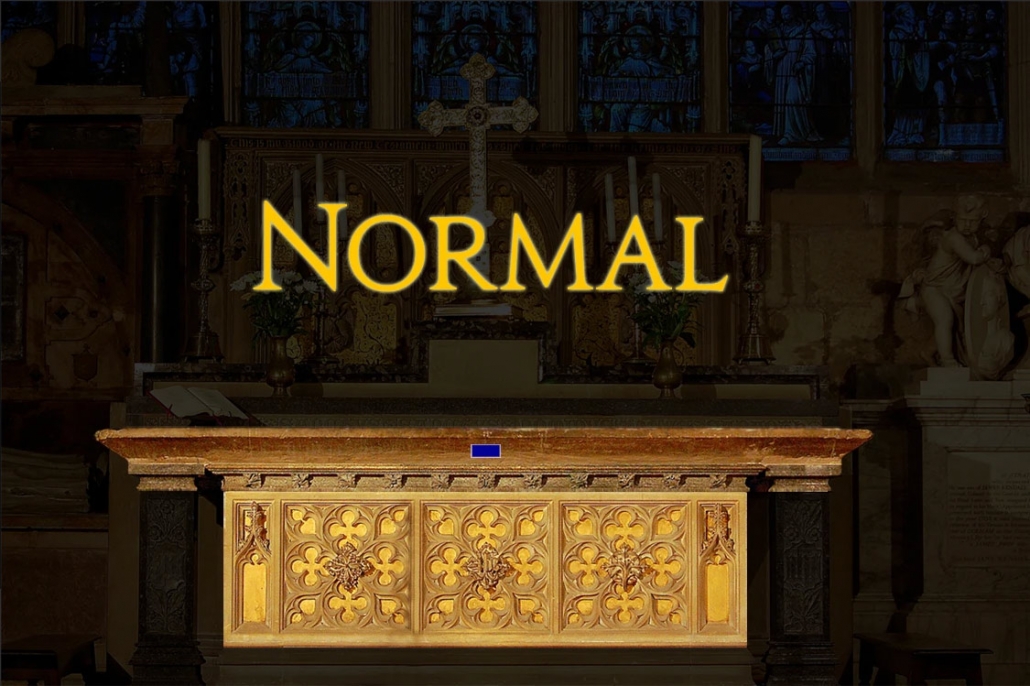
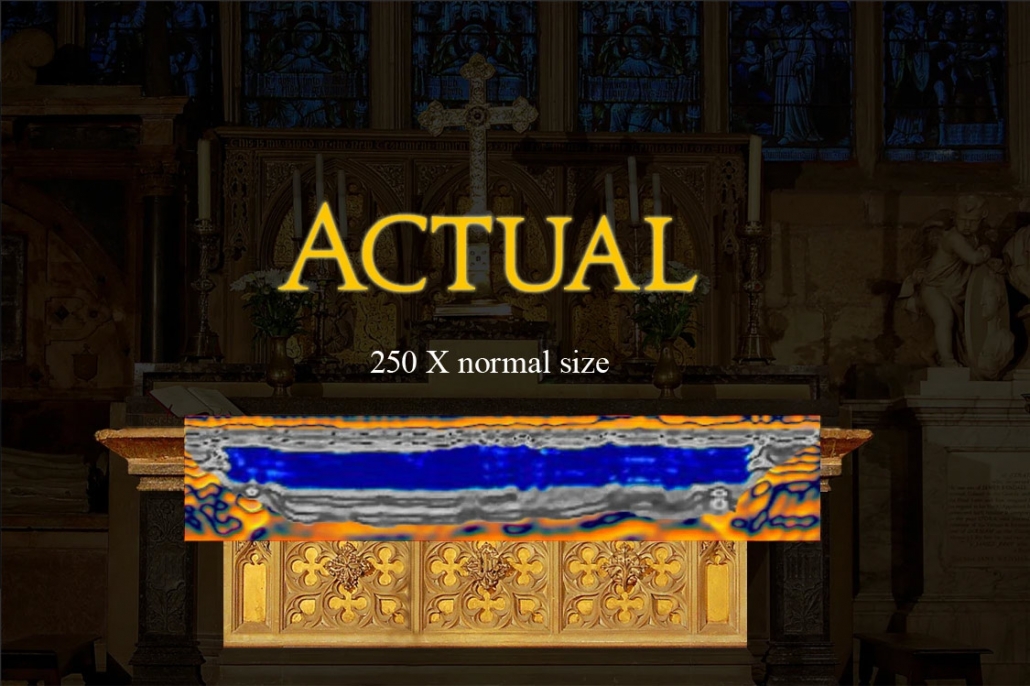
 In 1958 a heavily over-painted portrait of Christ, mistakenly thought to be the work of one of Leonardo’s pupils, was sold at auction for £45. In 2005 it was acquired for less than $10,000 by a group of art dealers who commissioned its restoration. On November 15th, 2017, the long-lost Salvatore Mundi was sold at auction by Christie’s in New York for $450.3 million!
In 1958 a heavily over-painted portrait of Christ, mistakenly thought to be the work of one of Leonardo’s pupils, was sold at auction for £45. In 2005 it was acquired for less than $10,000 by a group of art dealers who commissioned its restoration. On November 15th, 2017, the long-lost Salvatore Mundi was sold at auction by Christie’s in New York for $450.3 million!